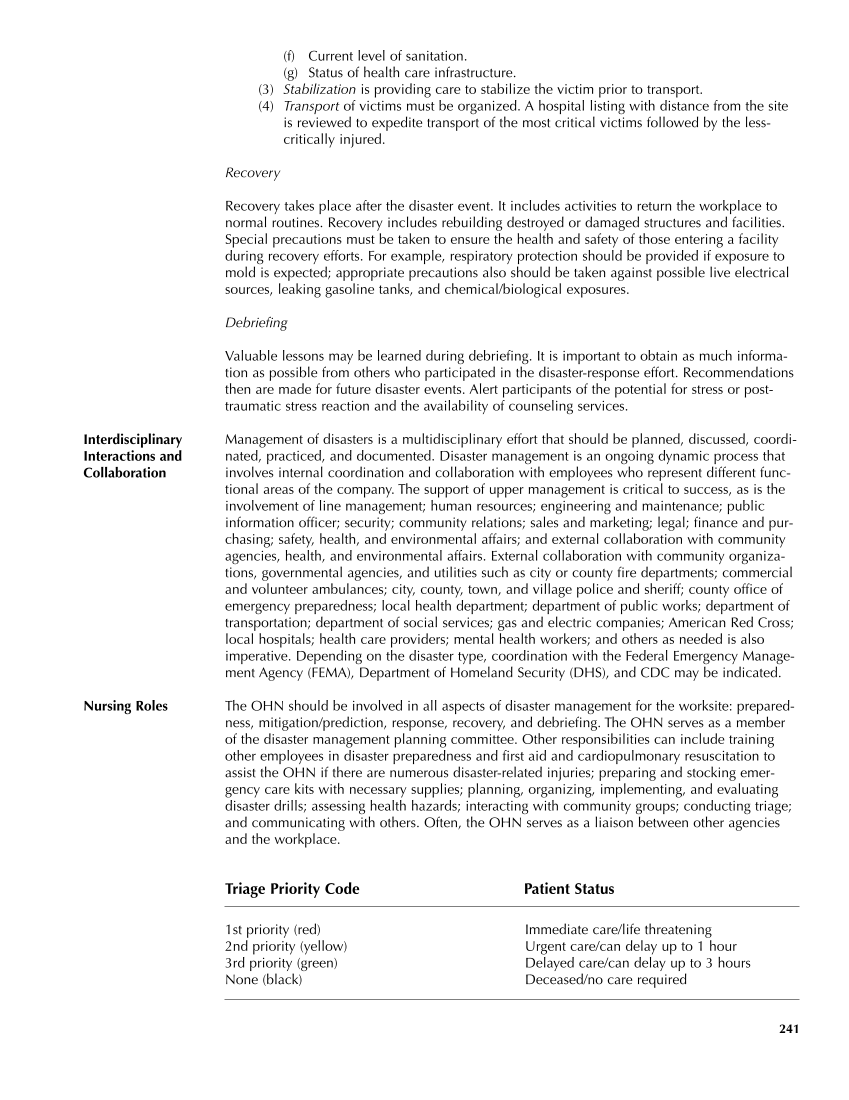(f) Current level of sanitation. (g) Status of health care infrastructure. (3) Stabilization is providing care to stabilize the victim prior to transport. (4) Transport of victims must be organized. A hospital listing with distance from the site is reviewed to expedite transport of the most critical victims followed by the less- critically injured. Recovery Recovery takes place after the disaster event. It includes activities to return the workplace to normal routines. Recovery includes rebuilding destroyed or damaged structures and facilities. Special precautions must be taken to ensure the health and safety of those entering a facility during recovery efforts. For example, respiratory protection should be provided if exposure to mold is expected appropriate precautions also should be taken against possible live electrical sources, leaking gasoline tanks, and chemical/biological exposures. Debriefing Valuable lessons may be learned during debriefing. It is important to obtain as much informa- tion as possible from others who participated in the disaster-response effort. Recommendations then are made for future disaster events. Alert participants of the potential for stress or post- traumatic stress reaction and the availability of counseling services. Management of disasters is a multidisciplinary effort that should be planned, discussed, coordi- nated, practiced, and documented. Disaster management is an ongoing dynamic process that involves internal coordination and collaboration with employees who represent different func- tional areas of the company. The support of upper management is critical to success, as is the involvement of line management human resources engineering and maintenance public information officer security community relations sales and marketing legal finance and pur- chasing safety, health, and environmental affairs and external collaboration with community agencies, health, and environmental affairs. External collaboration with community organiza- tions, governmental agencies, and utilities such as city or county fire departments commercial and volunteer ambulances city, county, town, and village police and sheriff county office of emergency preparedness local health department department of public works department of transportation department of social services gas and electric companies American Red Cross local hospitals health care providers mental health workers and others as needed is also imperative. Depending on the disaster type, coordination with the Federal Emergency Manage- ment Agency (FEMA), Department of Homeland Security (DHS), and CDC may be indicated. Nursing Roles The OHN should be involved in all aspects of disaster management for the worksite: prepared- ness, mitigation/prediction, response, recovery, and debriefing. The OHN serves as a member of the disaster management planning committee. Other responsibilities can include training other employees in disaster preparedness and first aid and cardiopulmonary resuscitation to assist the OHN if there are numerous disaster-related injuries preparing and stocking emer- gency care kits with necessary supplies planning, organizing, implementing, and evaluating disaster drills assessing health hazards interacting with community groups conducting triage and communicating with others. Often, the OHN serves as a liaison between other agencies and the workplace. Triage Priority Code Patient Status 1st priority (red) Immediate care/life threatening 2nd priority (yellow) Urgent care/can delay up to 1 hour 3rd priority (green) Delayed care/can delay up to 3 hours None (black) Deceased/no care required 241 Interdisciplinary Interactions and Collaboration
Purchased from OEM Press by (ge corporate access). (C) 2013 OEM Health Information, Inc. All rights reserved.












































































































































































































































































































































































































































